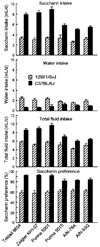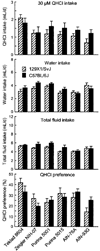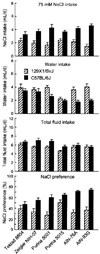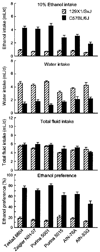The maintenance diets of C57BL/6J and 129X1/SvJ mice influence their taste solution preferences: implications for large-scale phenotyping projects
- PMID: 12163677
- PMCID: PMC2486364
- DOI: 10.1093/jn/132.8.2288
The maintenance diets of C57BL/6J and 129X1/SvJ mice influence their taste solution preferences: implications for large-scale phenotyping projects
Abstract
We examined the extent to which maintenance diet influences the taste preferences of mice. C57BL/6J (B6) and 129X1/SvJ (129) mice were fed one of three standard cereal-based diets (Teklad 8604, Zeigler NIH-07, Purina 5001), a cereal-based diet formulated for breeding (Purina 5015), or two purified diets (AIN-76A or AIN-93G). The mice were given 48-h two-bottle choice tests between water and the following seven taste solutions: 2 mmol/L saccharin, 5 mmol/L citric acid, 50 mmol/L citric acid, 30 micro mol/L quinine hydrochloride (QHCl), 300 micro mol/L QHCl, 75 mmol/L NaCl, and 10% ethanol. There were very few differences in taste solution preference scores among mice of the same strain fed the three different versions of standard cereal-based diet. There were also very few differences in taste solution preference scores between mice of the same strain fed the two purified diets. However, the mice fed standard cereal-based diets generally drank more water and total fluid than did mice fed purified diets. There were larger differences between the B6 and 129 strains in saccharin and ethanol preference scores with mice fed standard cereal-based diets than purified diets. Conversely, there were larger differences between the B6 and 129 strains in citric acid and NaCl preference scores with mice fed purified diets than standard cereal-based diets. These results show that maintenance diet composition can have strain-dependent effects on taste solution preference. They illustrate that attention must be paid to the effects of diet on phenotype in screens of mutagenized mice and other genetic studies.
Figures





Similar articles
-
Taste solution preferences of C57BL/6J and 129X1/SvJ mice: influence of age, sex, and diet.Chem Senses. 2007 Sep;32(7):655-71. doi: 10.1093/chemse/bjm034. Epub 2007 Jun 12. Chem Senses. 2007. PMID: 17566070 Free PMC article.
-
Mouse taste preference tests: why only two bottles?Chem Senses. 2003 May;28(4):315-24. doi: 10.1093/chemse/28.4.315. Chem Senses. 2003. PMID: 12771018 Free PMC article.
-
Influence of test duration on the sensitivity of the two-bottle choice test.Chem Senses. 2002 Nov;27(9):759-68. doi: 10.1093/chemse/27.9.759. Chem Senses. 2002. PMID: 12438201
-
Fat and sugar flavor preference and acceptance in C57BL/6J and 129 mice: experience attenuates strain differences.Physiol Behav. 2007 Mar 16;90(4):602-11. doi: 10.1016/j.physbeh.2006.11.012. Epub 2007 Jan 8. Physiol Behav. 2007. PMID: 17210165
-
Chorda tympani responses in two inbred strains of mice with different taste preferences.Physiol Behav. 1999 Aug;67(2):287-97. doi: 10.1016/s0031-9384(99)00071-2. Physiol Behav. 1999. PMID: 10477061 Review.
Cited by
-
Assessment of the Effects of 6 Standard Rodent Diets on Binge-Like and Voluntary Ethanol Consumption in Male C57BL/6J Mice.Alcohol Clin Exp Res. 2015 Aug;39(8):1406-16. doi: 10.1111/acer.12773. Epub 2015 Jun 25. Alcohol Clin Exp Res. 2015. PMID: 26110576 Free PMC article.
-
Standard rodent diets differentially impact alcohol consumption and preference and gut microbiome diversity.bioRxiv [Preprint]. 2024 Feb 7:2024.02.06.579237. doi: 10.1101/2024.02.06.579237. bioRxiv. 2024. Update in: Front Neurosci. 2024 May 13;18:1383181. doi: 10.3389/fnins.2024.1383181. PMID: 38370762 Free PMC article. Updated. Preprint.
-
Mice acquire flavor preferences during shipping.Physiol Behav. 2005 Nov 15;86(4):480-6. doi: 10.1016/j.physbeh.2005.08.031. Epub 2005 Sep 12. Physiol Behav. 2005. PMID: 16154605 Free PMC article.
-
Absence of a gestational diabetes phenotype in the LepRdb/+ mouse is independent of control strain, diet, misty allele, or parity.Sci Rep. 2017 Mar 24;7:45130. doi: 10.1038/srep45130. Sci Rep. 2017. PMID: 28338021 Free PMC article.
-
The Functional and Neurobiological Properties of Bad Taste.Physiol Rev. 2019 Jan 1;99(1):605-663. doi: 10.1152/physrev.00044.2017. Physiol Rev. 2019. PMID: 30475657 Free PMC article. Review.
References
-
- Li X, Inoue M, Reed DR, Huque T, Puchalski RB, Tordoff MG, Ninomiya Y, Beauchamp GK, Bachmanov AA. High-resolution genetic mapping of the saccharin preference locus (Sac) and the putative sweet taste receptor (T1R1) gene (Gpr70) to mouse distal chromosome 4. Mamm. Genome. 2001;12:13–16. - PMC - PubMed
-
- Schimenti J, Bucan M. Functional genomics in the mouse: phenotype-based mutagenesis screens. Genome Res. 1998;8:698–710. - PubMed
-
- Crabbe JC, Wahlsten D, Dudek BC. Genetics of mouse behavior: interactions with laboratory environment. Science (Wash., DC) 1999;284:1670–1672. - PubMed
-
- Tordoff MG, Bachmanov AA, Friedman MI, Beauchamp GK. Testing the genetics of behavior in mice [Letter] Science (Wash., DC) 1999;285:2069. - PubMed
Publication types
MeSH terms
Grants and funding
LinkOut - more resources
Full Text Sources
Molecular Biology Databases
